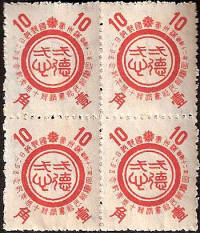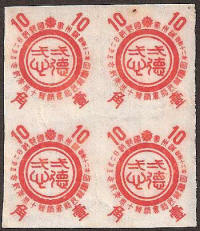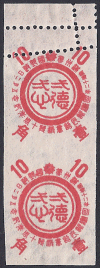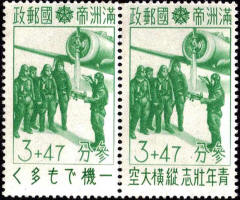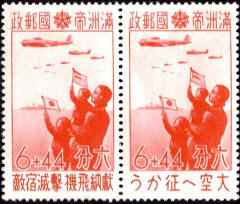 |
||||||
|
|
||||||
|
|
Postage Stamps Manchukuo Year 12 康德 Kāngdé 10th Anniversary of the Imperial Rescript 2nd May 1945. This was the last stamp to be printed by the Manchukuo Government on 8th August 1945 Soviet troops quickly invaded the country and returned sovereignty to China. These stamps were lithograph printed on watermarked (see below) "granite" paper in sheets of 100 by the Manchukuo Postal Administration Office, Hsinking. Design by Mr Yoai Ota. Number printed unknown. Any "specimen" stamps or sheets you may see for this issue are fakes. The stamps are 18mm x 21½mm. Perf 13 x 13½.
One value only, 10f inscribed 一 德 一 心 "One Virtue, One Heart" using Chinese seal script within a circular motif. This is normally shown as reading "One Heart, One Soul" in most British and American catalogues, an inaccurate translation. The original rescript was issued on 2nd May 1935 after Pu Yi returned from his first visit to Japan. Rescripts were not trivial things, they had to be memorised and recited by school children, army recruits and officials who would be punished for any mistakes. The sentiments expressed in the rescipts (mostly pro Japanese) carried the force of law.
|
|||||
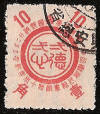 Used stamps are less common and have a higher value to collectors
|
Imperf on watermarked paper, with gum. |
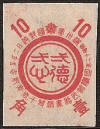 Imperf on watermarked paper, no gum
|
||||
|
. |
||||||
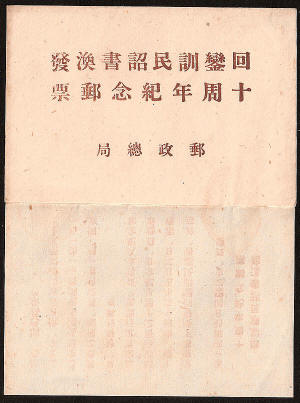
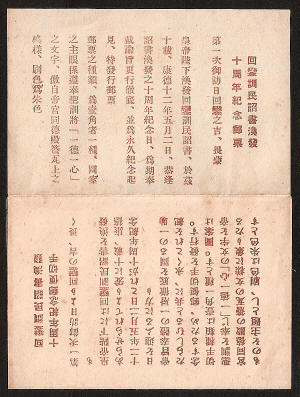 |
||||||
|
There is no presentation booklet
known for this issue, instead a single sample stamp was enclosed
in a simple paper envelope or wallet with details of the issue in
Chinese and Japanese. This wallet measures approx 105mm x 70mm when
folded. A translation provided by Richard Arent reads;
Imperial Rescript (or
Emperor's Edict) Circulated to the People
Tenth Anniversary Stamp
The Postal Administration graciously
announces the fist
visit of the Emperor to Japan.
May 2,
Kāngdé 12 marks the
tenth anniversary.
To commemorate the event a
postage stamp was issued. One stamp in the denomination of
1 chiao was issued. The design consists of the characters
[Yi De Yi Xin] written in block printing. The colour is
vermillion.
|
||||||
|
Click Here to see Errors and Plate Varieties
|
||||||
|
Unissued (Semi Postal) Stamps Known to Manchukuo collectors as the "semi-postals", this issue was in aid of the Patriot Aviation Fund, the idea being to raise additional revenue for the armed forces of Japan and Manchukuo. The pairs of stamps are bi-lingual with the slogan along the bottom reading 3+47f "The aspiration of the youth is as high and lofty as the airplanes in the sky" while the 6+44f reads "Donating to (enable) planes to defeat the enemy". (This is a slightly different translation from that of Harry Tamer who published one of the few articles about these stamps in the China Clipper). It should be noted that these stamps were for general use and were not designed as airmail stamps. When a customer paid 50f for a stamp, either 3f or 6f would represent the postage rate and the balance 47f or 44f would go to the war fund - hence the 3+47f and 6+44f prices. This was not a new idea, the Japanese published a set of "Patriotic Aviation Fund" stamps in 1937 but these were less ambitious in the amount of patriotism they expected of the donors, the series being 2+2s,3+2s and 4+2s. The stamps were ordered in 1944 when the letter rates were 3f and 6f and the anticipated release date was August of that year. A combination of late delivery and the postal price increases of 1st April 1944 meant that the stamps were rendered obsolete and could not be issued without a surcharge. Had the surcharge gone ahead the new prices are thought to have been set at 5+95f and 10+90f reflecting the new postal rates. The initial order was for 500,000 sets of which it is thought that 125,000 sets were produced. The stamps were never issued and any copies found today come from stocks looted in August 1945 or shortly afterwards, not having had a legitimate postal use they do not appear in many stamp catalogues. The part aircraft shown on the 3+47f stamp is a Mansyu 79 Ki Trainer or a derivative of the model (identified by Dick Bennett). The stamps were photogravure printed in se-tenant horizontal pairs, on un-watermarked, white paper in sheets of 50 by the Japanese Government Printing Bureau. The designer was Li Zhen-tai (李貞泰), who had studied design in Japan. He was introduced to Takeo Yamashita (of the Manchukuo Postal Bureau) by Wei Jie-fu (韋介夫), a member of the Manchukuo Stamp Club. The lady with the children shown on the 6+44f stamp was modelled on the wife of Wei*. The stamps are 22mm x 40mm. Perf 13 x 13½. Four Designs....
The 3f+47f show the training of
pilots using a model in front of a full size aircraft. 125,000
125,000 Scans courtesy of
Zander Oswald. *Information about
the designer comes courtesy of
Shiu-man Wan based upon his translation from the following
publication:
|
||||||
|
|
||||||


